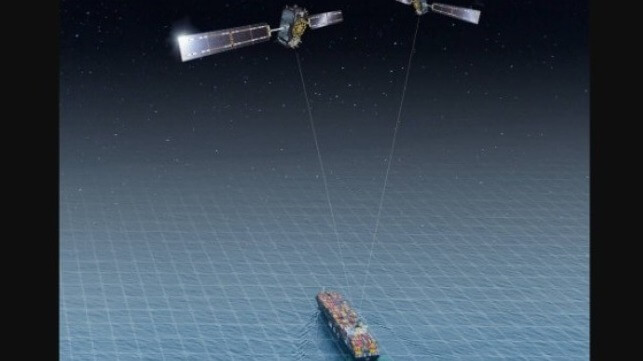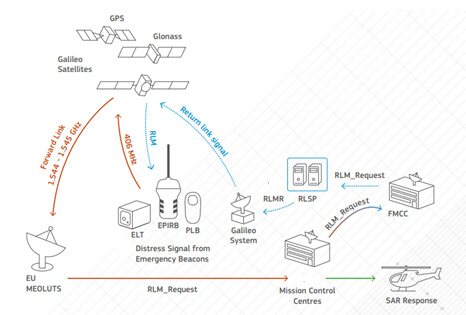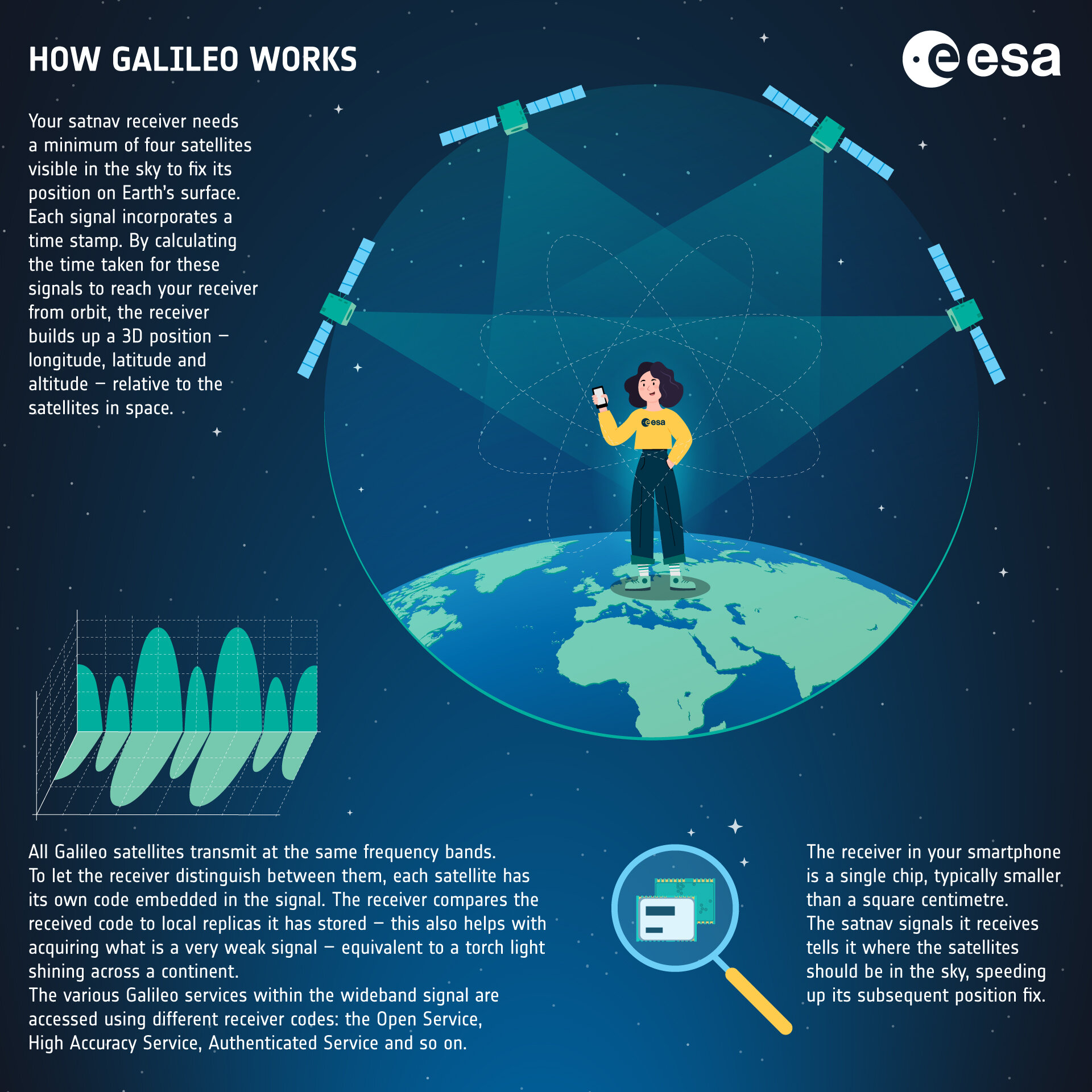
In 2016, Galileo was recognized by the International Maritime Organization as a component of the World Wide Radionavigation Systems (WWRNS).
Since then, Galileo has brought increased performances to maritime users.
On top of Galileo open service, two differentiators stand as flagships of the system for the near future: the high accuracy service (HAS) and the authenticated signal (OSNMA).
The HAS service was declared operational on January 24.
The OSNMA service is planned to be declared operational by end of 2023.
Galileo SAR as a consolidated service
Galileo SAR (Search And Rescue) service is part of Galileo services launched December 2016.
On January 21, 2020, the unique SAR Galileo with its RLS (Return Link Service) was declared operational, being completely integrated into the Cospas-Sarsat system.
Galileo SAR as a consolidated service
Galileo SAR (Search And Rescue) service is part of Galileo services launched December 2016.
On January 21, 2020, the unique SAR Galileo with its RLS (Return Link Service) was declared operational, being completely integrated into the Cospas-Sarsat system.
Maritime users benefit from Cospas-Sarsat, which helps them quickly being located in distress situations.
(See Figure 1) SAR beacons for maritime users using Galileo are already in the market.
Visit www.useGalileo.eu to have a database of the available Galileo-capable beacons in the market.

(See Figure 1) SAR beacons for maritime users using Galileo are already in the market.
Visit www.useGalileo.eu to have a database of the available Galileo-capable beacons in the market.

Figure 1: Galileo SAR
The importance of Galileo for the maritime sector
Officially recognized by the International Maritime Organization as part of its Worldwide Radio Navigation System, the importance of Galileo for the maritime sector is increasing over the years.
The use of Galileo could help improving technological innovation and help optimizing routes, contributing to the reduction of emissions due to maritime shipping [2] and therefore contribute to programs like the Zero-Emission Shipping Mission [1] (led by Denmark, Norway and US).
Furthermore, the benefits brought by Galileo have already been proven, being driven mainly through a substantial increase in accuracy, bigger coverage at high latitudes and better resiliency [2] [3] [4].
In practice, this is translated into a reduction of environmental impact, a better prediction of vessels, a decrease of risk collisions and more-efficient maneuverings, among others.
“The maritime community will continue benefitting from Galileo, in addition to the support that Galileo provides to search and rescue operations (Galileo SAR), the maritime community can now benefit from the new High Accuracy Service (HAS) - and soon from the Authentication Service (OSNMA)”, said Rodrigo da Costa, Executive Director of EUSPA, the European Union Agency implementing the EU Space Programme.
Maritime users benefiting from Galileo High Accuracy Service
Since 24 January, the Galileo High Accuracy Service (HAS) is providing free-of-charge high accuracy Precise Point Positioning (PPP) corrections through the Galileo E6-B signal and through internet (upon registration via the GNSS Service Center [5]).
The achieved typical accuracy performance, as depicted in the HAS Service Definition Document [5], is expected to be less than 25cm in the horizontal plane and 30cm in the vertical plane in nominal conditions based on Galileo signals.
For maritime users, a wide range of applications can greatly benefit from this service.
Merchant navigation and pilotage operations in ports, pilotage operations in inland waterways, port bathymetry, riverbed hydrographic survey, coastal seabed hydrographic survey, offshore supply vessels with dynamic positioning, autonomous surface vessels, in port terminal cranes and straddle carriers are some of them.
Thanks to the increased level of accuracy provided by HAS, the efficiency of operations can be improved, benefiting transportation and engineering operations.
Beyond the HAS initial service just declared, EUSPA managing the evolution of the Galileo service is already working on the subsequent evolution towards the HAS Full Service to be developed in the coming years.
For more information about HAS, refer to the High Accuracy Service Info Note Document, the Service Definition Document, the Signal in Space ICD and the Internet Data Distribution ICD, all of them available at :
https://www.gsc-europa.eu/electronic-library/programme-reference-documents#ACCURACY.
Galileo Authentication as an enabler of safety at the sea
In January 2021, the IMO issued a Resolution for maritime cyber-risk management.
The resolution recognizes “the urgent need to raise awareness on cyber risk threats and vulnerabilities.” During the COVID-19 pandemic, it was reported an increased number of cyberattacks.
It exposed the vulnerabilities of the maritime sector [6].
Galileo Open Service Navigation Message Authentication (OSNMA) provides a means to authenticate navigation data used in the positioning solution, ensuring that the information comes from Galileo Satellites, which significantly increases the security of the solution, contributing to the detection of potential spoofing attacks.
Galileo Authentication as an enabler of safety at the sea
In January 2021, the IMO issued a Resolution for maritime cyber-risk management.
The resolution recognizes “the urgent need to raise awareness on cyber risk threats and vulnerabilities.” During the COVID-19 pandemic, it was reported an increased number of cyberattacks.
It exposed the vulnerabilities of the maritime sector [6].
Galileo Open Service Navigation Message Authentication (OSNMA) provides a means to authenticate navigation data used in the positioning solution, ensuring that the information comes from Galileo Satellites, which significantly increases the security of the solution, contributing to the detection of potential spoofing attacks.
OSNMA is planned to deliver its service by the end of 2023.
It can be used by all types of receivers, as long as they decode the E1B signal component and have their firmware updated to process the new data.
The maritime domain can hugely benefit from this service, given that some key applications demand a new security layer, e.g. position reporting and fleet management.
The use of authentication in position reporting is applicable to any kind of vessels (merchant, fishing and leisure).
Its use is being promoted by IMO and IALA (e.g. Guidelines G1117, G1158).
Therefore, it is likely that for this type of application, authentication will be required in the future.
OSNMA is already transmitted (test phase) so that to allow manufacturers to test their solutions and be ready to introduce the new products in the market once the service is operational.
For more information about OSNMA, refer to the Galileo Open Service Navigation Message Authentication Info Note document, the OSNMA SiS ICD and the Receiver Guidelines, all of them available at :
https://www.gsc-europa.eu/electronic-library/programme-reference-documents#OSNMA.
For more information and support… ask the GNSS Service Centre
The GNSS Service Centre (GSC) (www.gsc-europa.eu) is part of Galileo infrastructure and acts as the interface between the users and Galileo Open (and OSNMA), and High Accuracy services.
GSC is managed by EUSPA, the EU Agency for the Space Programme.
The GSC is actively implied in promoting the use of Galileo among all different domains, maritime included, providing expert support.
Indeed, one of the main services offered is a helpdesk service where users can raise their questions about Galileo services.
Other information such as the status of the constellation, and the updated documentation related to the services offered are also available on the website (https://www.gsc-europa.eu/).
HAS and OSNMA Interface Control Documents and information about the testing campaigns can be found there.
Furthermore, the GSC is responsible for providing OSNMA public keys and certificates accessible to user communities using the service.
Links :
[1] http://mission-innovation.net/missions/shipping/
[2] https://prepare-ships.eu/
[3] https://www.gsc-europa.eu/news/h2h-leveraging-egnss-for-safer-maritime-navigation
[4] https://www.kongsberg.com/es/maritime/about-us/news-and-media/news-archive/2018/kongsberg-coordinates-eu-funded-project-to-enable-autonomous-navigation-in-close/
[5] https://www.gsc-europa.eu/electronic-library/programme-reference-documents#ACCURACY
[6] https://www.dnv.com/cybersecurity/cyber-insights/covid-19-has-increased-chances-of-maritime-cyber-assaults.html
[7]https://www.gsc-europa.eu/electronic-library/programme-reference-documents#OSNMA
For more information and support… ask the GNSS Service Centre
The GNSS Service Centre (GSC) (www.gsc-europa.eu) is part of Galileo infrastructure and acts as the interface between the users and Galileo Open (and OSNMA), and High Accuracy services.
GSC is managed by EUSPA, the EU Agency for the Space Programme.
The GSC is actively implied in promoting the use of Galileo among all different domains, maritime included, providing expert support.
Indeed, one of the main services offered is a helpdesk service where users can raise their questions about Galileo services.
Other information such as the status of the constellation, and the updated documentation related to the services offered are also available on the website (https://www.gsc-europa.eu/).
HAS and OSNMA Interface Control Documents and information about the testing campaigns can be found there.
Furthermore, the GSC is responsible for providing OSNMA public keys and certificates accessible to user communities using the service.
Links :
[1] http://mission-innovation.net/missions/shipping/
[2] https://prepare-ships.eu/
[3] https://www.gsc-europa.eu/news/h2h-leveraging-egnss-for-safer-maritime-navigation
[4] https://www.kongsberg.com/es/maritime/about-us/news-and-media/news-archive/2018/kongsberg-coordinates-eu-funded-project-to-enable-autonomous-navigation-in-close/
[5] https://www.gsc-europa.eu/electronic-library/programme-reference-documents#ACCURACY
[6] https://www.dnv.com/cybersecurity/cyber-insights/covid-19-has-increased-chances-of-maritime-cyber-assaults.html
[7]https://www.gsc-europa.eu/electronic-library/programme-reference-documents#OSNMA

No comments:
Post a Comment